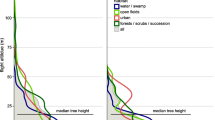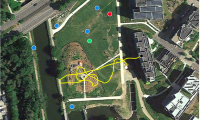Abstract
Molossid bats are specialised aerial-hawkers that, like their diurnal ecological counterparts, swallows and swifts, hunt for insects in open spaces. The long and narrow wings of molossids are considered energetically adapted to fast flight between resource patches, but less suited for manoeuvring in more confined spaces, such as between tree-tops or in forest gaps. To understand whether a potential increase in metabolic costs of manoeuvring excludes molossids from foraging in more confined spaces, we measured energy costs and speed of manoeuvring flight in two tropical molossids, 18 g Molossus currentium and 23 g Molossus sinaloae, when flying in a ~500 m3 hexagonal enclosure (~120 m2 area), which is of similar dimensions as typical forest gaps. Flight metabolism averaged 10.21 ± 3.00 and 11.32 ± 3.54 ml CO2 min−1, and flight speeds 5.65 ± 0.47 and 6.27 ± 0.68 m s−1 for M. currentium and M. sinaloae respectively. Metabolic rate during flight was higher for the M. currentium than for the similar-sized, but broader-winged frugivore Carollia sowelli, corroborating that broad-winged bats are better adapted to flying in confined spaces. These higher metabolic costs of manoeuvring flight may be caused by having to fly slower than the optimal foraging speed, and by the additional metabolic costs for centripetal acceleration in curves. This may preclude molossids from foraging efficiently between canopy trees or in forest gaps. The surprisingly brief burst of foraging activity at dusk of many molossids might be related to the cooling of the air column after sunset, which drives airborne insects to lower strata. Accordingly, foraging activity of molossids may quickly turn unprofitable when the abundance of insects decreases above the canopy.




Similar content being viewed by others
Abbreviations
- AP13CE:
-
13C Excess enrichment (in atom %)
- AR:
-
Aspect ratio
- F lift :
-
Lift force (N)
- F centripetal :
-
Centripetal force (N)
- g :
-
Gravitational force (9.81 m s−2)
- m b :
-
Body mass (kg)
- MC:
-
Molossus currentium
- MS:
-
Molossus sinaloae
- k c :
-
Fractional turnover (min−1)
- N c :
-
Body bicarbonate pool (mmol)
- t :
-
Time (min)
- v :
-
Flight speed (m s−1)
- v flown :
-
Flown flight speed (m s−1)
- v mr :
-
Maximum range flight speed (m s−1)
- v mp :
-
Minimum power flight speed (m s−1)
- \( \dot{V}_{{{\text{CO}}_{ 2} }} \) :
-
Rate of CO2 production (ml min−1)
References
Aubauer R (1994) Dreidimensionale Flugbahnverfolgung von Fledermäusen Fortschritte der Akustik – DAGA 94. DPG-Verlag, Bad Honnef, Germany
Barton AM, Fetcher N, Redhead S (1989) The relationship between treefall gap size and flight flux in a Neotropical rain forest in Costa Rica. J Trop Ecol 5:437–439
Chapman JW, Reynolds DR, Smith AD (2003) Vertical-looking radar: a new tool for monitoring high altitude insect migration. Bioscience 53:503–511
Dechmann DKN, Kranstauber B, Gibbs D, Wikelski M (2010) Group hunting: a reason for sociality in molossid bats? PLoS ONE 5:e9012
Dechmann DKN, Ehret S, Gaub A, Kranstauber B, Wikelski M (2011) Low metabolism in a tropical bat from lowland Panama measured with heart rate telemetry: an unexpected life in the slow rate. J Exp Biol 214:3605–3612
Engel S, Lease HM, McDowell NG, Corbett AH, Wolf BO (2009) The use of tunable diode laser absorption spectroscopy for rapid measurements of the δ13C of animal breath for physiological and ecological studies. Rapid Commun Mass Spectrom 23:1281–1286
Esbérard CEL, Bergallo HG (2010) Foraging activity of the free-tailed bat Molossus molossus (Chiroptera; Molossidae) in southeastern Brazil. Braz J Biol 70:011–1014
Fenton MB (1972) The structure of aerial-feeding bat faunas as indicated by ears and wing elements. Can J Zool 50:287–296
Freeman PW (1979) Specialized insectivory: beetle-feeding and moth eating molossid bats. J Mammal 60:467–479
Garland T Jr, Adolph SC (1994) Why not to do two-species comparative studies: limitations on inferring adaptation. Physiol Zool 67:707–828
Grodzinski U, Spiegel O, Korine C, Holderied MW (2009) Context-dependent flight speed: evidence for energetically optimal flight speed in the bat Pipistrellus kuhlii? J Anim Ecol 78:540–548
Hails CJ (1979) A comparison of flight energetics in hirundines and other birds. Comp Biochem Physiol 63:581–585
Hambly C, Voigt CC (2011) Measuring energy expenditure in birds using bolus injections of 13C labelled Na-bicarbonate. Comp Biochem Physiol A 158:323–328
Hambly C, Harper EJ, Speakman JR (2002) Cost of flight in the zebra finch (Taenopygia guttata): a novel approach based on elimination of 13C labelled bicarbonate. J Comp Physiol B 172:529–539
Hambly C, Pinshow B, Wiersma P, Verhulst S, Piertney SB, Harper EJ, Speakman JR (2004a) Comparison of the cost of short flights in a nectarivorous and a non-nectarivorous bird. J Exp Biol 207:3959–3968
Hambly C, Harper EJ, Speakman JR (2004b) The energy cost of loaded flight is substantially lower than expected due to alterations in flight kinematics. J Exp Biol 207:3969–3976
Holderied MW, von Helversen O (2003) Echolocation range and wingbeat period match in aerial-hawking bats. Proc Roy Soc B 270:2293–2299
Holderied MW, Jones G, von Helversen O (2006) Flight and echolocation behaviour of whiskered bats commuting along a hedgerow: range-dependent sonar signal design. Doppler tolerance and evidence for ‘acoustic focussing’. J Exp Biol 209:116–1826
Jung K, Kalko EKV (2011) Adaptability and vulnerability of high flying neotropical aerial insectivorous bats to urbanization. Diversity Distrib 17:1–13
Masman D, Klaasen M (1987) Energy expenditure during free flight in trained and free-living Eurasian kestrels Falco tinnunculus. Auk 104:603–616
McCracken GF, Gillam EH, Westbrook JK, Lee YF, Jensen ML, Balsley BB (2008) Brazilian free-tailed bats (Tadarida brasiliensis: Molossidae, Chiroptera) at high altitude: links to migratory insect populations. Integr Comp Biol 48:107–118
Norberg UM (1986) Evolutionary convergence in foraging niche and flight morphology in insectivorous aerial hawking birds and bats. Ornis Scand 117:253–269
Norberg UM, Rayner JMV (1987) Ecological morphology and flight in bats (Mammalia; Chiroptera): wing adaptations, flight performance, foraging strategy and echolocation. Phil Trans Roy Soc Lond B 316:335–427
Pennycuick CJ (1975) Mechanics of flight. In: Farner DS, King JR (eds) Avian biology, vol 5. Academic Press, London, pp 1–75
Pennycuick CJ (2008) Modelling the flying bird. Academic Press, London
Rayner JMV (1982) Avian flight energetics. Ann Rev Physiol 44:109–119
Rayner JMV (1999) Estimating power curves of flying vertebrates. J Exp Biol 202:3449–3461
Schmidt-Nielsen K (1997) Animal physiology: adaptation and environment. Cambridge University Press, Cambridge
Schmidt-Wellenburg CA, Biebach H, Daan S, Visser GH (2007) Energy expenditure and wing beat frequency in relation to body mass in free flying Barn Swallows (Hirundo rustica). J Comp Physiol B 177:327–337
Speakman JR (1997) Doubly labeled water: theory and practice. Chapman and Hall, London
Speakman JR, Racey PA (1991) No cost of echolocation for bats in flight. Nature 350:421–423
Speakman JR, Thomas D (2003) Physiological ecology and energetics of bats. In: Kunz TH, Fenton BM (eds) Bat ecology. The University of Chicago Press, Chicago, pp 430–492
Speakman JR, Thomson SC (1997) Validation of the labelled bicarbonate technique for measurement of short-term energy expenditure in the mouse. Z Ernährungswiss 36:273–277
Vaughan TA (1986) Morphology and flight characteristics of molossid bats. J Mammal 47:249–260
Voigt CC, Lewanzik D (2011) Trapped in the darkness of the night: thermal and energetic constraints of daylight flight in bats. Proc Roy Soc Lond B 278:2311–2317
Voigt CC, von Helversen O, Michener R, Kunz TH (2001) The economics of harem maintenance in the sac-winged bat, Saccopteryx bilineata (Emballonuridae). Behav Ecol Sociobiol 50:31–36
Voigt CC, Kelm DH, Visser GH (2006) Field metabolic rates of phytophagous bats: do pollination strategies of plants make life of nectar-feeders spin faster? J Comp Physiol B 176:213–222
Voigt CC, Schuller BM, Greif S, Siemers BM (2010) Perch-hunting in insectivorous Rhinolophus bats is related to the high energy costs of manoeuvring in flight. J Comp Physiol B 180:1079–1088
Voigt CC, Schneeberger K, Voigt-Heucke SL, Lewanzik D (2011) Rain increases the energy cost of bat flight. Biol Lett 7:793–795
Winter Y, von Helversen O (1998) The energy cost of flight: do small bats fly more cheaply than birds? J Comp Physiol B 168:105–111
Acknowledgments
The authors thank Daniel Lewanzik, Ivailo Borrisov, Karin Schneeberger and Silke L. Voigt-Heucke for help during the 2010 field work, and Daniela Rabaiotti, Eugenia Cordero, Frederick Sutton and Luke Worley for help during the 2011 field work. They thank Silke Voigt-Heucke for comments on an earlier draft, the organisation for tropical studies for allowance to work at La Selva biological station and the authorities for granting research permission.
Author information
Authors and Affiliations
Corresponding author
Additional information
Communicated by G. Heldmaier.
Rights and permissions
About this article
Cite this article
Voigt, C.C., Holderied, M.W. High manoeuvring costs force narrow-winged molossid bats to forage in open space. J Comp Physiol B 182, 415–424 (2012). https://doi.org/10.1007/s00360-011-0627-6
Received:
Revised:
Accepted:
Published:
Issue Date:
DOI: https://doi.org/10.1007/s00360-011-0627-6




